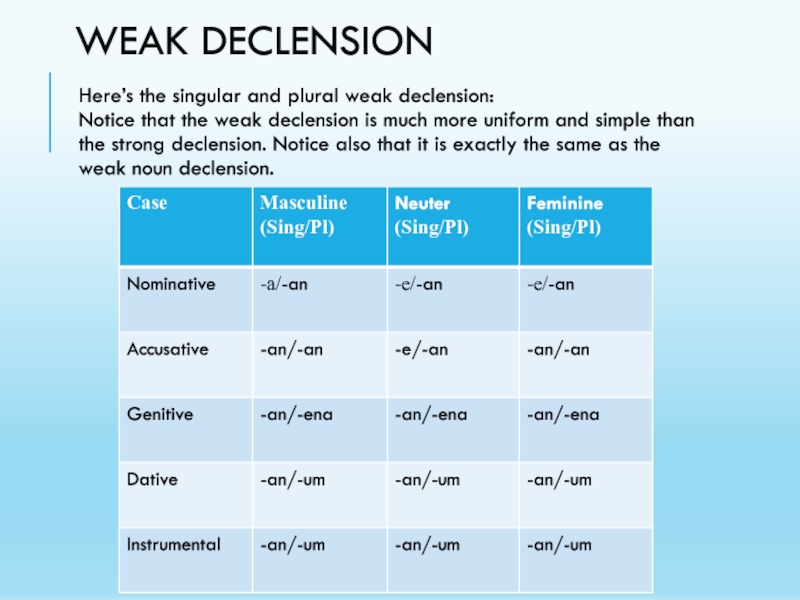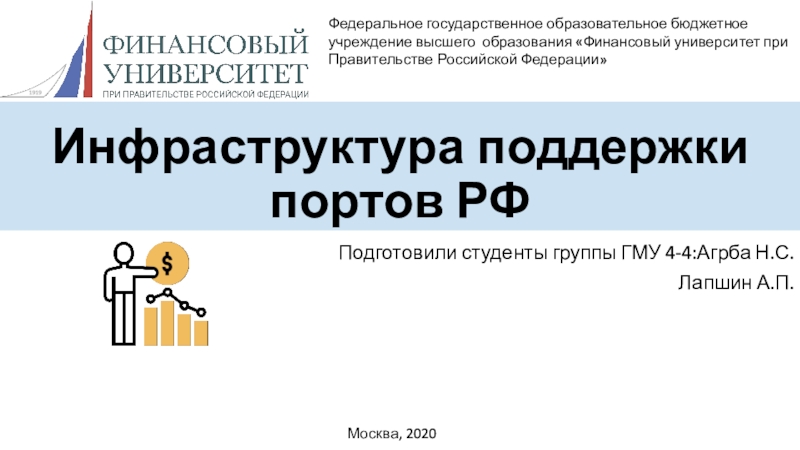Разделы презентаций
- Разное
- Английский язык
- Астрономия
- Алгебра
- Биология
- География
- Геометрия
- Детские презентации
- Информатика
- История
- Литература
- Математика
- Медицина
- Менеджмент
- Музыка
- МХК
- Немецкий язык
- ОБЖ
- Обществознание
- Окружающий мир
- Педагогика
- Русский язык
- Технология
- Физика
- Философия
- Химия
- Шаблоны, картинки для презентаций
- Экология
- Экономика
- Юриспруденция
Old English Adjectives
Содержание
- 1. Old English Adjectives
- 2. Adjectives in general-Adjectives are words that describe
- 3. Strong DeclensionAdjectives in Old English agree with
- 4. example "Gōd" - "good“
- 5. Plural&ExampleNotice that genitive and dative are the
- 6. Adjectives with æ in the stemIf an
- 7. Adjectives with -ƿWe shall give ġearu ("ready")
- 8. This again can be explained in terms
- 9. Adjectives with -eAdjectives such as sƿēte ("sweet")
- 10. Weak DeclensionHere’s the singular and plural weak
- 11. Example "Gōd" - "good“
- 12. Strong or Weak?You can tell when to
- 13. Comparatives and SuperlativesThe comparative and superlative forms
- 14. Comparatives and SuperlativesThe superlative adjective mostly take
- 15. Скачать презентанцию
Adjectives in general-Adjectives are words that describe or modify other wordsOld English adjectives had the grammatical categories of gender, number and case (nominative, genitive, dative, accusative and partly, instrumental).OE adjectives as
Слайды и текст этой презентации
Слайд 2Adjectives in general
-Adjectives are words that describe or modify other
words
and case (nominative, genitive, dative, accusative and partly, instrumental).OE adjectives as well as OE nouns had two types of declension: strong and weakСлайд 3Strong Declension
Adjectives in Old English agree with the noun they
describe in case, gender, and number. There are several variations
on the general declension, but overall, adjectives decline thus: Singular: Notice that the genitive, dative, and instrumental feminine are all -re, the masculine and neuter genetive are both "-es", and masculine and neuter dative are both "-um", and masculine and neuter instrumental are both "-e". Also, the neuter adjective adds no ending in the nominative/accusative case, just like neuter nouns themselves. Basically, you can see that the adjective ending will roughly correspond to the article ending (þæs and -es, þǣm and -um, þǣre and -re', etc.Слайд 5Plural&Example
Notice that genitive and dative are the same in all
genders for plural. Note also the instrumental is exactly the
same as the dative. The "-e" ending for nominative and accusative feminine was used in later Old English.Слайд 6Adjectives with æ in the stem
If an adjective has a
monosyllabic stem and has æ for its vowel, and the
æ is followed by a single consonant, as in the words glæd ("glad") and blæc ("black), then an extra rule comes into play: the æ changes to an a whenever the adjective acquires a suffix which begins with a vowel. For example, here is the strong declension of glæd (glad). There is no need to supply the weak declension, since in the weak declension every suffix begins with a vowel.Слайд 7Adjectives with -ƿ
We shall give ġearu ("ready") as an example
of this type of adjective. Here is the strong declension:
Слайд 8This again can be explained in terms of a few
simple rules:
· Where the ordinary strong declension has no suffix,
-ƿ adjectives have the suffix -u.· Where the ordinary strong declension has a suffix beginning with a consonant, -ƿ adjectives have an o followed by the appropriate suffix.
· Where the ordinary strong declension has a suffix beginning with a vowel, -ƿ adjectives have a ƿ followed by the appropriate suffix.
There is no need to give the weak declension, since in the weak declension every number and case has a suffix beginning with a vowel; -ƿ adjectives will therefore uniformly precede this suffix with a ƿ.
Слайд 9Adjectives with -e
Adjectives such as sƿēte ("sweet") follow a very
simple rule: the e at the end is displaced by
any suffix, but stays where it is if there is no suffix. Hence the strong declension looks like this:Слайд 10Weak Declension
Here’s the singular and plural weak declension:
Notice that the
weak declension is much more uniform and simple than the
strong declension. Notice also that it is exactly the same as the weak noun declension.Слайд 12Strong or Weak?
You can tell when to use the strong
or weak declension.
An adjective would be declined weak if:
1. It
was always declined weak (like most ordinal numbers, and all comparative adjectives)2. It was preceded by the definitive article ("se/sēo/þæt" and all its declined forms), either of the demonstratives ("se/sēo/þæt" and all its declined forms and "þes/þis/þēos" and all its declined forms), or any possessive personal pronoun (mīn, þīn, sīn) except for the third person possessive pronouns ("his/hire/heora") - unless the adjective was one of the few adjectives that were always declined strong, like ōðer - "second"
3. It was used in a nickname and came after the personal name it modified.
In all other cases, the adjective was declined strong, including if it came after a linking verb:
· Iċ eom grēat - "I am great"
· Þā ƿihta ƿǣron fǣtta - "The creatures were fat").
Слайд 13Comparatives and Superlatives
The comparative and superlative forms are like Modern
English "more" and "most", as is "more intelligent" and "most
intelligent" or "better" and "best".In Old English, all comparative adjectives were declined according to the weak declension - no matter what. The comparative degree was usually formed with the suffix "-ra" (the "a" being the weak masculine singular ending - so it should be replaced by other grammatical endings when it is declined). The superlative degree ("most") was usually formed by adding the suffix "-ost" to an adjective; but like the normal positive degree, it was sometimes declined weak and sometimes declined strong (see the "Strong or Weak?" section above for more information). For example:
· ƿīs ("wise") - ƿīsra ("wiser") - ƿīsost ("wisest")
· cræftiġ ("crafty, skilled") - cræftiġra ("craftier, more skilled") - cræftigost ("craftiest, most skilled")
· hefiġ ("heavy, important") - hefiġra (""heavier, more important") - hefigost ("heaviest, most important")
Слайд 14Comparatives and Superlatives
The superlative adjective mostly take the weak declension
however for the nominative, accusative and the neuter case can
take the strong.Some common adjectives undergo i-mutation in the comparative and superlative, and have -est instead of -ost as the superlative suffix. Examples are:
· eald ("old") - ieldra ("older") - ieldest ("oldest") (Note the same mutation in archaic Modern English "elder"/"eldest".)
· ġeong ("young") - ġingra ("younger") - ġingrest ("youngest")
· hēah ("high") - hīerra ("higher") - hīehst ("highest")
· strang ("strong") - strengra ("stronger") - strengest ("strongest")
· lang ("long") - lengra ("longer") - lengest ("longest")
Some adjectives formed their comparative and superlative degrees irregularly, and need to be memorized:
· gōd ("good") - betera ("better") - betst ("best")
· yfel ("bad, evil") - ƿirsa ("worse") - ƿirst ("worst")
· lytel ("little, small") - læssa ("smaller, less") - læst
· miċel ("much, great") - māra ("more, greater") - mǣst ("most, greatest")

































